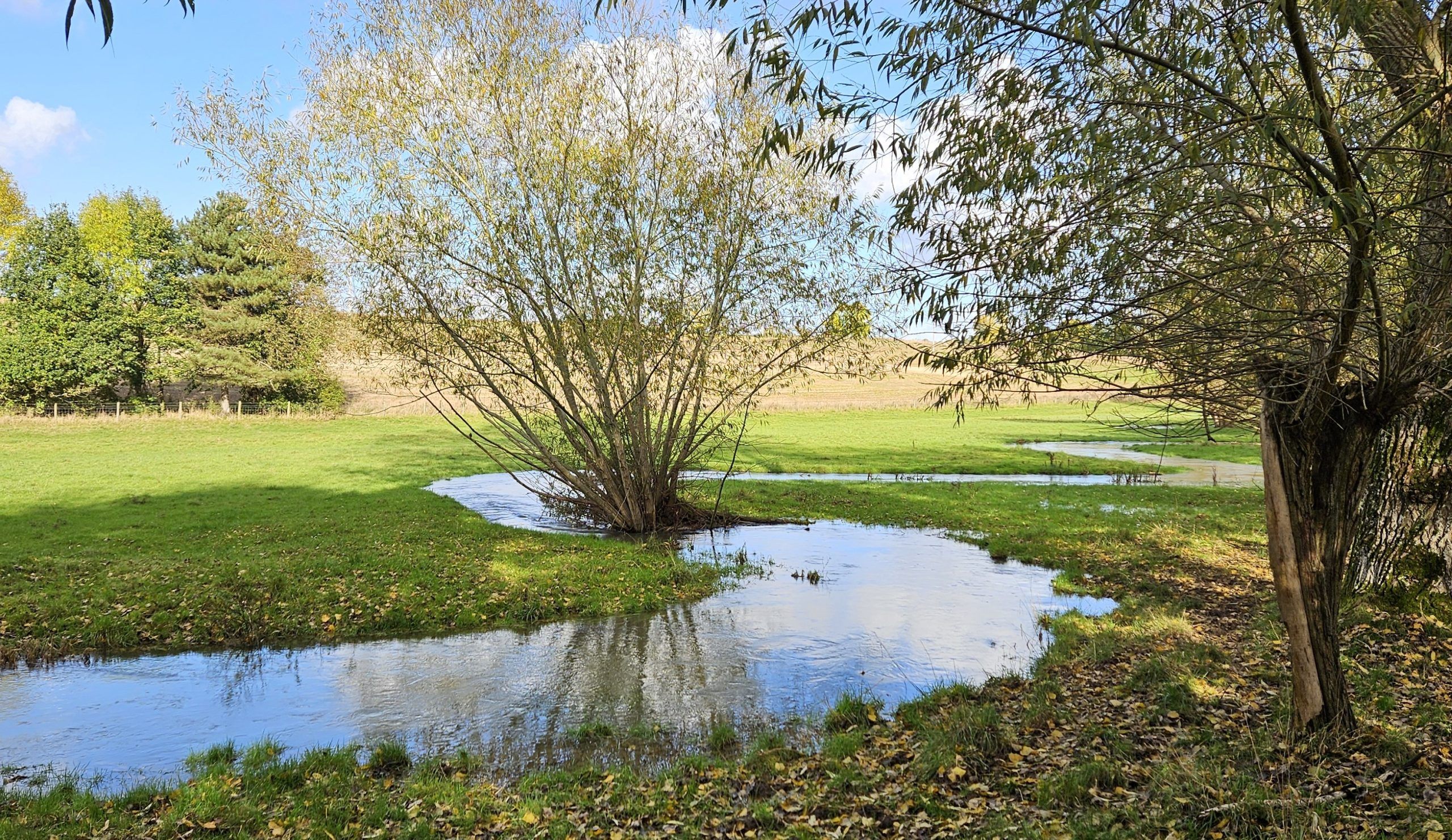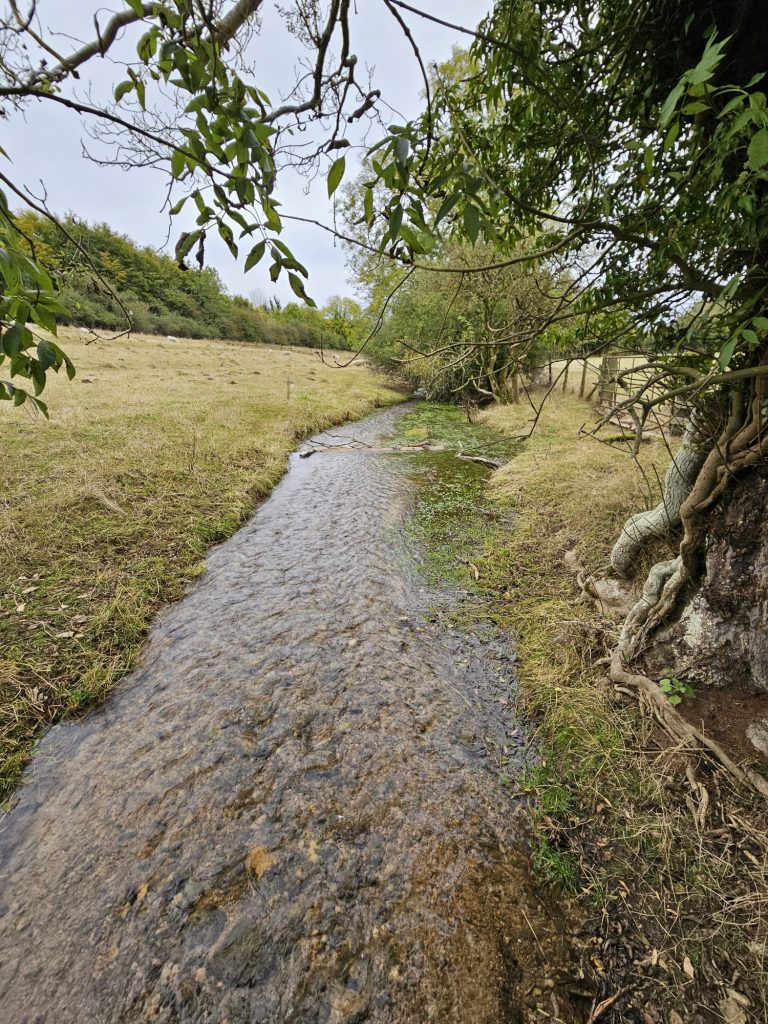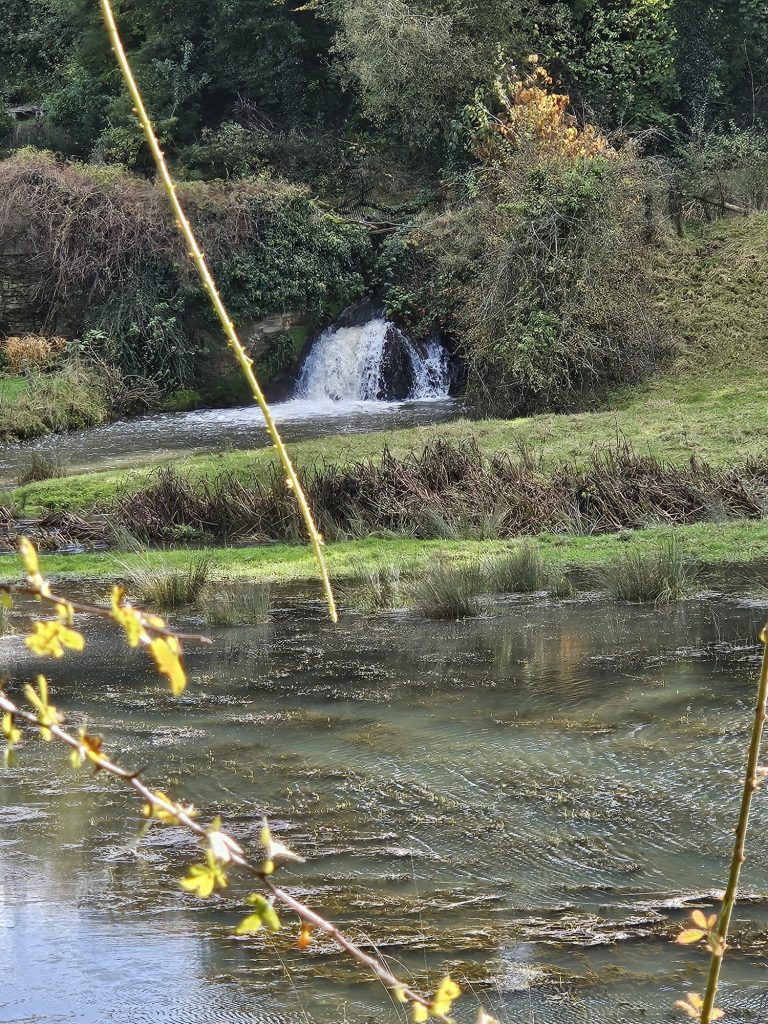
Bright stream
Following the River Glyme through Oxfordshire – and its extraordinary history. A version of this piece appeared in Caught by the River on 13 March 2025 – link at end.
It’s just a slip of a stream, sixteen miles from clean spring to silt-dulled lake-end. It gleams down shallow valleys, meanders through meadows, shines below willows. Glyme
Megaliths were hauled upright on its slopes, millennia before the Romans wound their watermills against its flow. At some point during seven Saxon centuries it was named the glim, the bright stream. Lidstone
It has spun grain-grinders, wool-beaters, and a bone-crusher to feed the fields by the chalk ford, where the lost villages now slumber in humped outlines. Chalfords
Once, a feasting queen plucked a bauble from rose-coloured jets while a hermit sang echoes in a gilded grotto. What a night that was. Now the mundane road churns incurious traffic over that golden secret place, indifferent. Enstone
Where its leat drops over rocks, John the Fuller dug clay to smooth the cloth, his work unravelable. Here rides John Zanewyrthe to grant him land. Cleveley, Radford
Dammed for Cydda, it basks the manor in its lake reflections, then, languid, melts before an Arab prince. Kiddington, Glympton
Narrowed once more, it flows to the farm by the wood. By the palisade, another queen awaits its final flourish. Wootton, Woodstock
Then it is received, endlessly.
Footnotes on the names (and some explanations!)
The Glyme is a short and slender river that rises near Chipping Norton in Oxfordshire and runs sixteen miles south to Woodstock. Its name comes from glim (Old English) and means ‘bright stream.’

The villages that the Glyme passes through are named for many things: Lidstone and Enstone are called after neolithic megaliths. The Hoarstone and the remains of a burial chamber can still be seen near a crossroads at Enstone.
The villages of Nether, Upper and Over Chalford (Celford in the Domesday Book), all sited near the ford where the chealh or limestone was carried across, began to fade away in the late Middle Ages, although some outlines can still be seen.
At Cleveley, the river is diverted from the meadow (ley) to flow down a rocky outcrop (cliff/cleve). Radford (ride + ford) is where one could cross by horse. John Zayneworth lived by Gagingwell on the other side of the river from Cleveley and sold land to John the Fuller.

Some of the mills along the Glyme started as cornmills and became fulling mills as the wool trade grew. Fulling is a cloth-finishing process that makes woollen material smooth and shrink-proof. The technique involves water and wooden hammers and requires fine clay, or fuller’s earth. Fuller’s earth is still used as a decontaminant, filter and decolouriser. By the 11th century, the process was mechanised – water wheels powered a cam which in turn lifted the hammers to strike the cloth. John the Fuller lived in Cleveley around the 1250s. The hamlet of Fulwell (the ‘dirty stream’, presumably containing the clay) sits above a tributary of the Glyme.
Cydda’s manor became Kiddington, where a now a grand manor house sits above a trout lake created from the Glyme in Capability Brown’s first endeavour in Oxfordshire. The river flows into another ornamental lake at Glympton (named after the river). The 2,000-acre Glympton estate was in the Wheate family for 300 years. In 2020, its current owner, the King of Bahrain, bought it from Prince Bandar bin Sultan, former ambassador to the US, who had spent £42m on extensive renovations, including bullet-proofing, and had a replica English pub built in the grounds.
The villages of Wootton and Woodstock are both settlements (ton) by the wood, the latter perhaps having a palisade defence (stoc).
The story of the queen at Enstone is quite fantastical. In 1626, Thomas Bushell, who grew up under the protection of Francis Bacon, moved to Enstone and had a cavity dug out of the hill to make a place he could sit and read, and contemplate ‘the fine cleane streame which petrifies.’ Thus a ‘goldwell was emancipated’, according to Enstone’s Victorian vicar John Jordan, when the works uncovered a rocky hollow with stalactites. Here Bushell installed a fountain, along with a statue of Neptune aiming an arrow at a duck being pursued by a spaniel. On fine evenings, he would walk around his ‘paradise’ all night. In 1636, King Charles I and Queen Henrietta visited the grotto and were treated to a display. A hermit was hired to appear and there was singing to demonstrate the echoes. At the end of the Royal banquet, two dancing, pink-coloured jets of water rose up from the river, tossing up two golden balls. The queen reached out for one and found it contained a ‘marchepaine’ (sweetmeat), while the king’s bauble held a little portrait of the queen in ivory. Thereafter the Glyme’s river grotto was called Queen Henrietta’s Waterworks, but began to decay rapidly only a few years later during the Civil War.
The Glyme ends at the Queen Pool, once a 14th century fish pool that was a favourite of Queen Philippa, wife of Edward III. The pool was expanded by Capability Brown in 1763 to create the great lake at Blenheim Palace. By that time, a Grand Bridge was already in place, overwhelming the small river Glyme that ran beneath it, and evidently looking rather ridiculous, prompting Alexander Pope to joke that minnows in the stream must have taken on “the grandeur of whales as they swam underneath it”. Shortly after leaving Blenheim Palace grounds, the Glyme is ‘received’ by another Cotswold river, the Evenlode, and together they join the Thames near Oxford.